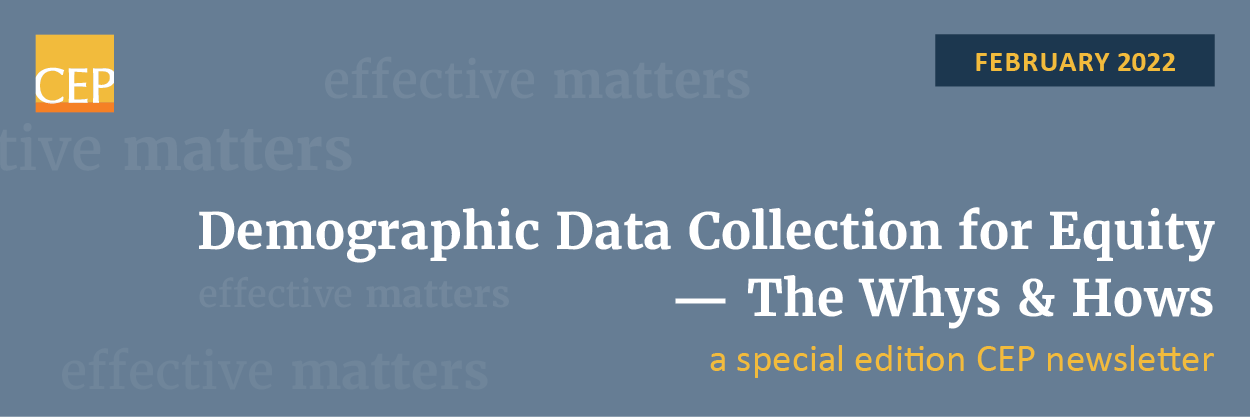
As many funders have increased their focus on racial equity in recent years, demographic data collection has taken on new significance and attention. The Center for Effective Philanthropy’s (CEP) recent report Foundations Respond to Crisis: Lasting Change? found that “about 40 percent of interviewed foundation leaders said that, since the beginning of 2020, they have begun or are increasingly focused on better collecting and using demographic data about nonprofits they fund and the people they serve.” In this special edition newsletter, we have collected resources, examples, practical how-to guides for funders, and perspectives on demographic data collection.
Resources for Demographic Data Collection:
PEAK Grantmaking recently released a collection of four how-to guides and an action planner: Driving Equity With Demographic Data Collection. These resources (some available only to PEAK members) provide in-depth guidance for funders seeking to assess why and how they collect demographic data, navigate legal and privacy concerns, and put a plan for demographic data collection into action, including how to communicate effectively with grantees and partners about data collection. The resources include:
- Action Planner | Driving Equity With Demographic Data
- How-To Guide | Understand the Power of Equitable Data Collection
- How-To Guide | Decide on a Demographic Data Taxonomy
- How-To Guide | Navigate the Legal and Privacy Landscape Surrounding Demographic Data
- How-To Guide | Communicate Effectively About Your Demographic Data
Candid and Change Philanthropy offer a demographic survey that is freely available to nonprofits to collect this information at their own organizations — and that makes its easy for nonprofits to add to Candid’s GuideStar nonprofit profiles, creating a centralized data repository of U.S.-based nonprofits. Find their guide for collecting and using DEI data here.
Asian Americans/Pacific Islanders in Philanthropy (AAPIP) have compiled a collection of resources on the subjects of ethnicity data and data disaggregation, including reports, statements, and blogs that indicate why ethnicity data collection and disaggregation is crucial.
Perspectives & Examples: Demographic Data Collection in Action
In conversation: Using data to deepen understanding
The David and Lucile Packard Foundation recently partnered with Candid to encourage their grantees and applicants to complete Candid’s GuideStar profiles and demographic surveys. The Foundation’s CEO Nancy Lindborg discusses the motivation behind the partnership and their hope for its impact with former Candid President Bradford Smith.
In this blog post, Hewlett Foundation’s Larry Kramer, Sara Davis, and Charmaine Mercer describe how improving their demographic data collection was a core part of their commitment to diversity, equity, and inclusion. In addition to sharing their motivations, they describe insights into the data as well as actions they are taking in response, and they share a public version of the tool they use to visualize the data. In a companion post, CEP’s Kevin Bolduc and Della Menhaj discuss the creation of the demographic survey tool, which CEP supported.
Supporting Native Populations With Demographic Data
In a Q&A with Chantias Ford, community knowledge manager at PEAK Grantmaking, Carly Bad Heart Bull, executive director of the Native Ways Federation, discusses the importance of demographic data collection — and disaggregating data — if philanthropy is to better serve Native communities.
Collecting and Understanding Demographic Data to Advance Equity, Diversity, and Inclusion
As a part of their commitment to equity, diversity, and inclusion and reflective of a value for evidence-based action, the Robert Wood Johnson Foundation sought to develop and launch a demographic survey for use both internally and with those with whom they work. Brian Quinn and Priya Gandhi describe the process, their motivations, and reflections after the results in this post.
Overlooked: CEP’s Reports on Foundation Support for AAPI & Native American Leaders and Communities
Collected across thousands of nonprofits and connected to those organizations’ perceptions of their funders, demographic data can provide a powerful lens on how race and ethnicity can affect the funder-grantee relationship. CEP’s Ellie Buteau and her colleagues on our research team recently shared two research reports describing concerning trends for Asian American and Pacific Islander and Native American nonprofit leaders and communities.
Latest on the CEP Blog
Demographic Data Collection: The Personal, the Practical, and the Potential for Impact
Kevin Bolduc reminds us of the personal weight demographic data can carry, as well as their value in enabling funders to assess their funding decisions and make impactful change, sharing some of the work CEP is doing to support funders in collecting and using this information.
Advancing Equity with Better Demographic Data Collection Practices
CEP’s Naomi Orensten and Katarina Malmgren share data from recent CEP research that reveals that foundation leaders have much yet to do when it comes to thoughtfully collecting and using demographic data.
The Importance of Talking About — and Collecting Data on — Race to Improve Racial Equity
Senior Director of Research at Candid Cathleen Clerkin reminds us of the power of language when it comes to social identity. She calls on foundations to collect demographic data in a way that minimizes the burden on grantees but still enables a clearer picture of who is being served.
Interested in engaging CEP to better understand how you can collect and use demographic data at your organization? Reach out to Kevin Bolduc for more information.